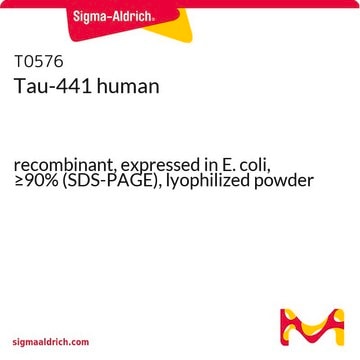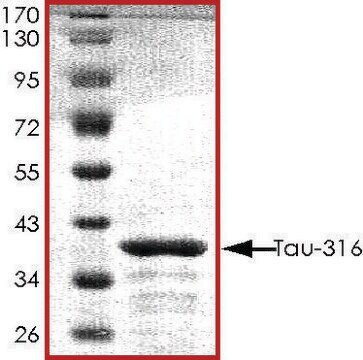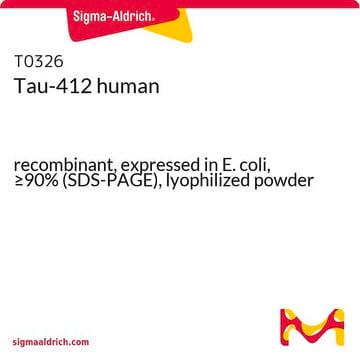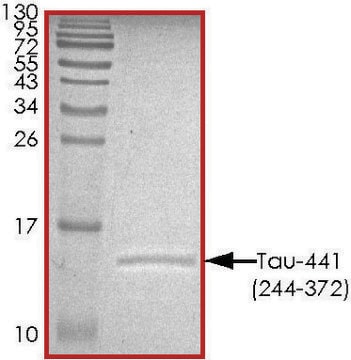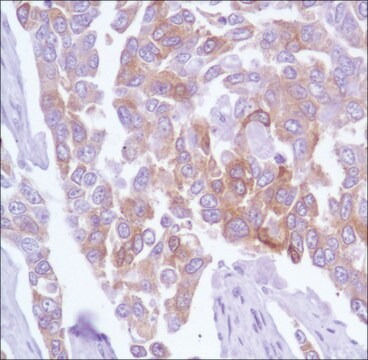T7951
Tau Protein Ladder, 6 isoforms human
recombinant, expressed in E. coli, ≥90% (SDS-PAGE), buffered aqueous glycerol solution
Sinônimo(s):
Tau Protein Ladder
About This Item
Produtos recomendados
fonte biológica
human
Nível de qualidade
recombinante
expressed in E. coli
Ensaio
≥90% (SDS-PAGE)
forma
buffered aqueous glycerol solution
peso molecular
36800
39700
40000
42600
42900
45900
composição
dodecyl sulphate sodium salt, 1-5%
glycerine, 20-30%
mercaptoethanol, 10-20%
técnica(s)
immunoelectrophoresis: 10-20 μL using recombinant Tau protein marker
western blot: 2-5 μL using recombinant Tau protein marker
nº de adesão UniProt
Condições de expedição
dry ice
temperatura de armazenamento
−20°C
Informações sobre genes
human ... MAPT(4137)
Descrição geral
Tau gene, spanning 100 kb with 16 exons, is mapped to human chromosome 17q21. The six alternative splice variants of protein ranging in size from 352-441 amino acids have been identified in human adult brain. Tau is a member of the microtubule-associated protein (MAP) family. It is predominantly expressed in neurons.
Aplicação
Ações bioquímicas/fisiológicas
Embalagem
Especificações
forma física
Armazenamento e estabilidade
to qualified or authorized persons
anticorpo
produto relacionado
Palavra indicadora
Danger
Frases de perigo
Declarações de precaução
Classificações de perigo
Acute Tox. 3 Dermal - Acute Tox. 4 Oral - Aquatic Chronic 3 - Eye Dam. 1 - Repr. 2 - Skin Irrit. 2 - Skin Sens. 1 - STOT RE 2 Oral
Órgãos-alvo
Liver,Heart
Código de classe de armazenamento
6.1C - Combustible acute toxic Cat.3 / toxic compounds or compounds which causing chronic effects
Classe de risco de água (WGK)
WGK 3
Certificados de análise (COA)
Busque Certificados de análise (COA) digitando o Número do Lote do produto. Os números de lote e remessa podem ser encontrados no rótulo de um produto após a palavra “Lot” ou “Batch”.
Já possui este produto?
Encontre a documentação dos produtos que você adquiriu recentemente na biblioteca de documentos.
Os clientes também visualizaram
Nossa equipe de cientistas tem experiência em todas as áreas de pesquisa, incluindo Life Sciences, ciência de materiais, síntese química, cromatografia, química analítica e muitas outras.
Entre em contato com a assistência técnica